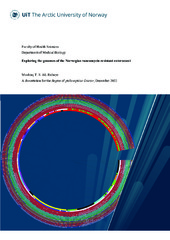| dc.contributor.advisor | Hegstad, Kristin | |
| dc.contributor.author | AL-Rubaye, Mushtaq Talib Shawi | |
| dc.date.accessioned | 2023-03-05T15:56:00Z | |
| dc.date.available | 2023-03-05T15:56:00Z | |
| dc.date.issued | 2023-03-24 | |
| dc.description.abstract | Enterococci are gram-positive commensals in the human gut microbiota that may cause severe infections, especially in immunocompromised and hospitalised patients. Their ability to accumulate antimicrobial resistance and virulence genes has been vital in their evolution into leading pathogens. Vancomycin resistant enterococci (VRE) are among the most important resistant pathogens causing outbreaks worldwide. In this study, we aimed to examine recent developments in the epidemiology of VRE in Norway related to the occurrence of novel van-types and the increasing incidence of VRE since 2010.
By analysing whole genome sequencing data produced in this project, we identified and described the first Norwegian vanD-type VRE isolates from two patients and reported a novel vanD-subtype and genomic islands harbouring the vanD gene clusters and reported vanD gene cluster in vancomycin resistant Enterococcus casseliflavus for the first time. Different vanD subtypes harbouring genomic islands and phylogenetic, genomic distance confirmed that the isolates of the two cases are clonally unrelated. Additionally, we identified the first vanE-type VRE isolates in Norway recovered from the same patient and described the mobile genetic element harbouring (MGE) the vanE gene cluster, its insertion site, and explained why one isolate expressed inducible low level and the other isolate constitutive low level vancomycin resistance.
Moreover, we conducted the first comprehensive study on Norwegian VRE and vancomycin susceptible Enterococcus faecium (VSEfm) at the genomic level and identified the most prevalent cluster types (CTs), compared their virulomes, and MGEs harbouring the van gene clusters.
In conclusion the population structure of E. faecium in Norway is shaped by globally prevalent clones, particularly concurrent European CTs, with similar dynamic ST sweeps. The dominant CTs of VREfm have acquired more virulence determinants than the more diverse local VSEfm population. | en_US |
| dc.description.doctoraltype | ph.d. | en_US |
| dc.description.popularabstract | Enterococci are a group of bacteria that naturally live in our gut and acquire genetic material (DNA) that help them become resistant to antibiotics. Vancomycin is an important antibiotic against enterococci that have acquired resistance to commonly used antibiotics. The vancomycin resistant form of enterococci (VRE) is thus an important challenge in healthcare settings globally. VRE can cause serious infections, especially in hospitalized patients with reduced immune system. The incidence of VRE in Norway has been low but increased significantly since 2010.
We collected individual VRE from 2010-15 and compared their DNA to vancomycin susceptible enterococci (VSE) and detected new variants of VRE. The main results showed that the overall situation in Norway is like other European countries with circulation of easily transmissible VSE that later acquire new DNA creating VRE. This is important knowledge to be able to implement targeted measures to prevent the occurrence and spread of VRE. | en_US |
| dc.description.sponsorship | The thesis was funded by Helse Nord for this project as a three years PhD position. | en_US |
| dc.identifier.uri | https://hdl.handle.net/10037/28673 | |
| dc.language.iso | eng | en_US |
| dc.publisher | UiT The Arctic University of Norway | en_US |
| dc.publisher | UiT Norges arktiske universitet | en_US |
| dc.relation.haspart | <p>Paper I: AL-Rubaye, M.T.S., Janice, J., Bjørnholt, J.V., Jakovljev, A., Hultström, M.E., Sundsfjord, A. & Hegstad, K. (2021). Novel genomic islands and a new vanD-subtype in the first sporadic VanD-type vancomycin resistant enterococci in Norway. <i>PLoS One, 16</i>(7), e0255187. Also available in Munin at <a href=https://hdl.handle.net/10037/21992>https://hdl.handle.net/10037/21992</a>.
<p>Paper II: AL-Rubaye, M., Janice, J., Bjørnholt, J.V., Löhr, I.H., Sundsfjord, A. & Hegstad, C The first vanE-type vancomycin resistant <i>Enterococcus faecalis</i> isolates in Norway – phenotypic and molecular characteristics. (Manuscript).
<p>Paper III: AL-Rubaye, M., Janice, J., Bjørnholt, J.V., Kacelnik, O., Haldorsen, B.C., Nygaard, R.M., Hegstad, Sundsfjord, A., Hegstad, K. & the Norwegian VRE study group. The population structure of vancomycin resistant and susceptible <i>Enterococcus faecium</i> in a low prevalence antimicrobial resistance setting is highly influenced by global clones. (Manuscript). | en_US |
| dc.rights.accessRights | openAccess | en_US |
| dc.rights.holder | Copyright 2023 The Author(s) | |
| dc.rights.uri | https://creativecommons.org/licenses/by-nc-sa/4.0 | en_US |
| dc.rights | Attribution-NonCommercial-ShareAlike 4.0 International (CC BY-NC-SA 4.0) | en_US |
| dc.subject | VDP::Medical disciplines: 700::Health sciences: 800::Epidemiology medical and dental statistics: 803 | en_US |
| dc.subject | VDP::Medisinske Fag: 700::Helsefag: 800::Epidemiologi medisinsk og odontologisk statistikk: 803 | en_US |
| dc.title | Exploring the genomes of the Norwegian vancomycin resistant enterococci | en_US |
| dc.type | Doctoral thesis | en_US |
| dc.type | Doktorgradsavhandling | en_US |


 English
English norsk
norsk
